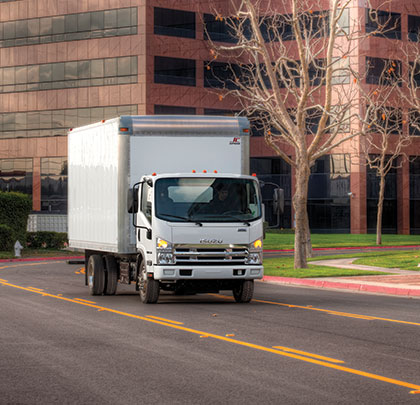High fuel prices are here to stay. Today, the average cost per gallon of diesel fuel in the U.S.¹ is at or near the $4 threshold. But did you know that every year, business owners could save thousands of dollars by making one simple change? What is this “miracle?” Simple: Change the driver’s habits.
A few years ago, Isuzu undertook an extensive study of commercial truck driver’s driving habits. The results were so amazing that they staged “Fuel Economy Challenges” all around the country to demonstrate the power of changing driving habits. The lessons they learned can pay dividends by cutting your fuel costs.
IMPROVE FUEL ECONOMY
So let’s explore what you can do to improve fuel economy: First, it starts by operating a fuel-efficient truck. Isuzu offers a full line of medium-duty trucks—its N-Series trucks accommodate GVWRs from 12,000 to 19,500 pounds. Plus, Isuzu offers two efficient diesel engines, as well as a 6.0L V8 gasoline engine that can be optionally configured for LPG or CNG alternative fuel. Isuzu is the only medium-duty truck company that offers a LCF (low-cab-forward) truck with the choice of gasoline, LPG or CNG. This variety allows you to select the trucks you need to match the power-to-weight and transportation requirements of your specific application. In addition, all Isuzu engines are 50-state EPA compliant and certified².
Second, after you have a fuel-efficient vehicle, you have to know how to operate it efficiently. So, here are some easy-to-follow tips that can have a huge impact (based on Isuzu’s real-world testing, these tips have been proven to reduce fuel consumption by an average of 33 percent):
Slow down: On the highway, drivers can improve fuel economy by 10 to 12 percent when speed is reduced between 5 to 10 mph.
Maintain a consistent speed: Driving at a consistent 45 mph can improve fuel economy by 14 percent compared to someone who was on and off the gas.
Careful acceleration: From a stop, gradually depress the accelerator pedal, allowing the transmission to shift into the next gear. Avoid “jack rabbit” starts. Tests showed a 21 percent improvement in fuel economy when taking it easy from 0 to 35 mph.
Know the right way to brake: Make sure drivers know how to use engine braking and the exhaust brake, as that can affect fuel consumption:
- To increase fuel economy, set the exhaust brake to OFF, then plan decelerations in advance, whenever possible.
- Engine braking alone requires a longer distance to slow the truck, but does not consume fuel. Using the exhaust brake with engine braking shortens the braking distance, but increases fuel consumption.
- Drivers should always use their best judgment to utilize the most effective and safe method of braking, based on road grade, vehicle load, and other road conditions.

Reduce idling: Excessive engine idling, especially if the air conditioning is left on, reduces fuel economy. Ask drivers to reduce unnecessary idling at service stations, making pick-ups and deliveries, and at other destinations (FYI: “excessive” is anything over 2 minutes).
Tire rotation and proper tire pressure: This small, but important, step increases fuel economy and extends the life of the tires.
Employ a “smart truck:” All Isuzu-built diesel-power trucks can produce a “Vehicle Health Report” for owners that detail fuel consumption, vehicle speed, acceleration habits, braking frequency, and idling. Studying this data helps owners see the “real-world” driving habits, then they can respond with fuel-efficient suggestions.
Used together, these fuel-conscious driving tips can translate into substantial savings for your business. Isuzu’s tests showed that a single truck averaging 35,000 miles annually could reduce fuel consumption by over 1,200 gallons per year by implementing these techniques. At $4 per gallon, this translates into a savings of $4,800 per truck. For a fleet of 50 trucks, it means a savings of $240,000 per year!
So drive smart, save fuel, and save money with Isuzu. ■
1 www.eia.gov/petroleum/gasdiesel
2 All current Isuzu diesel models meet EPA 2010 and California Air Resources Board HD-OBD emissions standards and are clean-idle certified; Isuzu NPR ECO-MAX, NPR-HD, NQR, and NRR trucks were the first in their class to offer Selective Catalytic Reduction (SCR) technology with Diesel Exhaust Fluid (DEF).
For More Information:
For more information on Isuzu, visit www.isuzucv.com.
_________________________________________________________________________
Modern Contractor Solutions, July 2013
Did you enjoy this article?
Subscribe to the FREE Digital Edition of Modern Contractor Solutions magazine.



